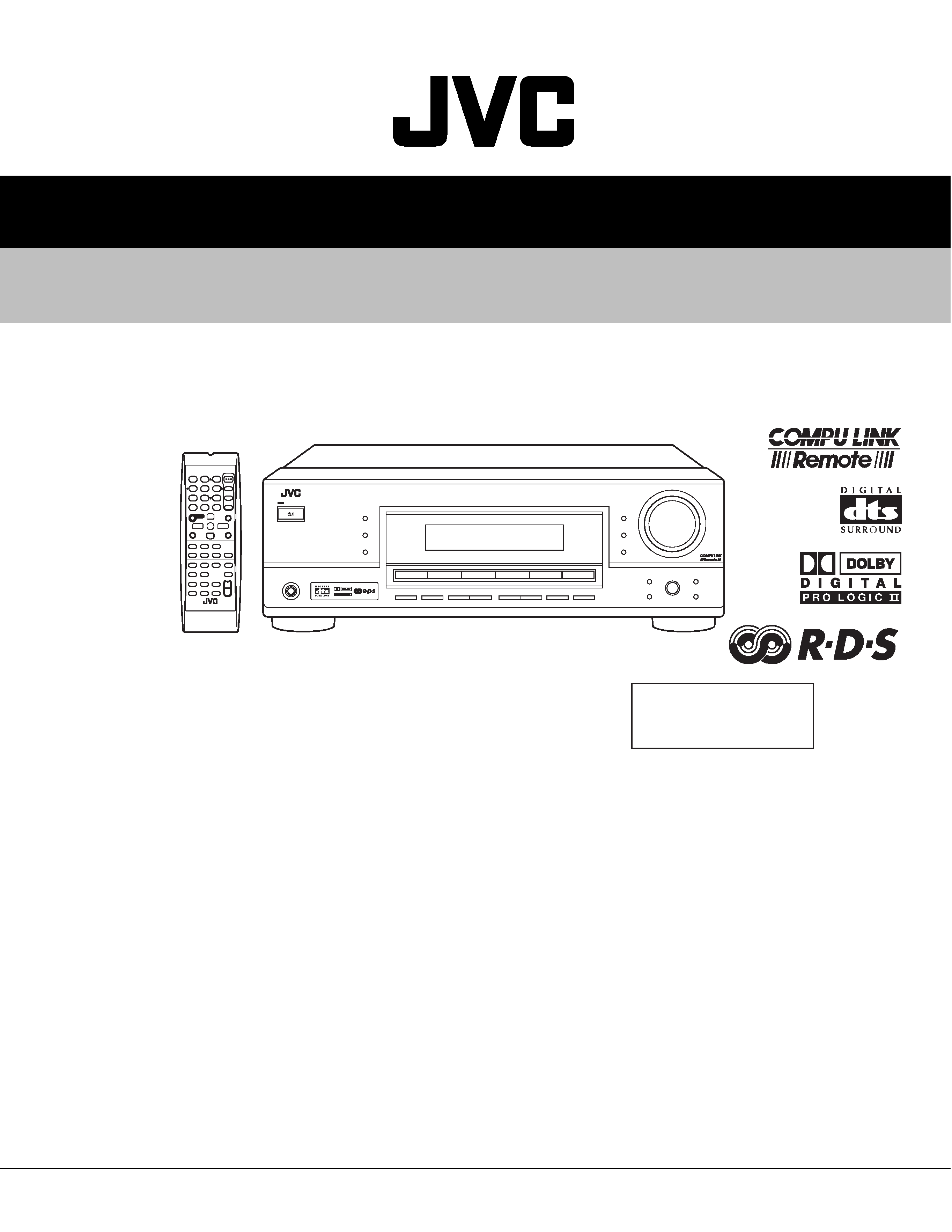
SERVICE MANUAL
COPYRIGHT © 2003 VICTOR COMPANY OF JAPAN, LTD.
No.22038
2003/4
AUDIO/VIDEO CONTROL RECEIVER
22038
2003
4
RX-5032VSL
TABLE OF CONTENTS
1
Important Safety Precautions . . . . . . . . . . . . . . . . . . . . . . . . . . . . . . . . . . . . . . . . . . . . . . . . . . . . . . . . . . . 1-2
2
Disassembly method . . . . . . . . . . . . . . . . . . . . . . . . . . . . . . . . . . . . . . . . . . . . . . . . . . . . . . . . . . . . . . . . . . 1-3
3
Adjustment. . . . . . . . . . . . . . . . . . . . . . . . . . . . . . . . . . . . . . . . . . . . . . . . . . . . . . . . . . . . . . . . . . . . . . . . . . 1-10
4
Description of major ICs . . . . . . . . . . . . . . . . . . . . . . . . . . . . . . . . . . . . . . . . . . . . . . . . . . . . . . . . . . . . . . . 1-11
TA/NEWS/INFO
DISPLAY MODE
STANDBY
STANDBY/ON
PHONES
DIGITAL
PRO LOGIC
DIMMER
INPUT DIGITAL
RXÐ6030V AUDIO/VIDEO CONTROL RECEIVER
INPUT ANALOG
MASTER VOLUME
INPUT ATT
Area Suffix
E ----- Continental Europe
EN ----- Northern Europe
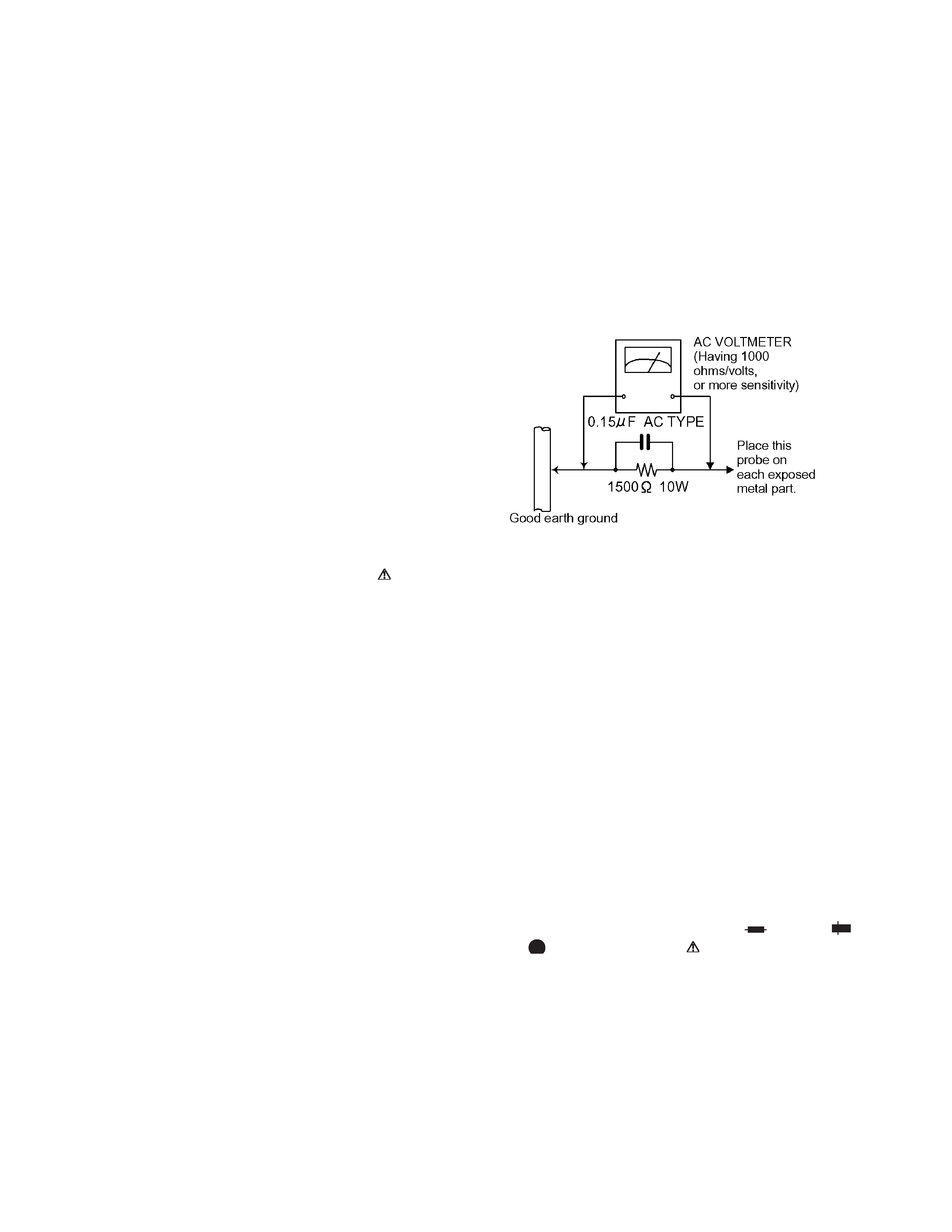
1-2 (No.22038)
SECTION 1
Important Safety Precautions
1.1 Safety Precautions
(1) This design of this product contains special hardware and
many circuits and components specially for safety purposes.
For continued protection, no changes should be made to the
original design unless authorized in writing by the man-
ufacturer. Replacement parts must be identical to those
used in the original circuits. Services should be per-
formed by qualified personnel only.
(2) Alterations of the design or circuitry of the product should
not be made. Any design alterations of the product should
not be made. Any design alterations or additions will void
the manufacturers warranty and will further relieve the
manufacture of responsibility for personal injury or property
damage resulting therefrom.
(3) Many electrical and mechanical parts in the products have
special safety-related characteristics. These characteris-
tics are often not evident from visual inspection nor can the
protection afforded by them necessarily be obtained by us-
ing replacement components rated for higher voltage, watt-
age, etc. Replacement parts which have these special safety
characteristics are identified in the Parts List of Service Manu-
al. Electrical components having such features are iden-
tified by shading on the schematics and by (
) on the
Parts List in the Service Manual. The use of a substitute re-
placement which does not have the same safety character-
istics as the recommended replacement parts shown in the
Parts List of Service Manual may create shock, fire, or oth-
er hazards.
(4) The leads in the products are routed and dressed with ties,
clamps, tubings, barriers and the like to be separated from
live parts, high temperature parts, moving parts and/or
sharp edges for the prevention of electric shock and fire
hazard. When service is required, the original lead routing
and dress should be observed, and it should be confirmed
that they have been returned to normal, after reassembling.
(5) Leakage shock hazard testing)
After reassembling the product, always perform an isolation
check on the exposed metal parts of the product (antenna
terminals, knobs, metal cabinet, screw heads, headphone
jack, control shafts, etc.) to be sure the product is safe to
operate without danger of electrical shock.
Do not use a line isolation transformer during this check.
· Plug the AC line cord directly into the AC outlet. Using a
"Leakage Current Tester", measure the leakage current
from each exposed metal parts of the cabinet, particular-
ly any exposed metal part having a return path to the
chassis, to a known good earth ground. Any leakage cur-
rent must not exceed 0.5mA AC (r.m.s.).
· Alternate check method
Plug the AC line cord directly into the AC outlet. Use an AC
voltmeter having, 1,000 ohms per volt or more sensitivity in
the following manner. Connect a 1,500 ohm 10W resistor
paralleled by a 0.15 µF AC-type capacitor between an
exposed metal part and a known good earth ground.
Measure the AC voltage across the resistor with the AC
voltmeter.
Move the resistor connection to each exposed metal part,
particularly any exposed metal part having a return path to
the chassis, and measure the AC voltage across the resistor.
Now, reverse the plug in the AC outlet and repeat each
measurement. Voltage measured any must not exceed 0.75
V AC (r.m.s.). This corresponds to 0.5 mA AC (r.m.s.).
1.2 Warning
(1) This equipment has been designed and manufactured to
meet international safety standards.
(2) It is the legal responsibility of the repairer to ensure that
these safety standards are maintained.
(3) Repairs must be made in accordance with the relevant
safety standards.
(4) It is essential that safety critical components are replaced
by approved parts.
(5) If mains voltage selector is provided, check setting for local
voltage.
1.3 Caution
Burrs formed during molding may be left over on some parts
of the chassis.
Therefore, pay attention to such burrs in the case of pre-
forming repair of this system.
1.4 Critical parts for safety
In regard with component parts appearing on the silk-screen
printed side (parts side) of the PWB diagrams, the parts that are
printed over with black such as the resistor (
), diode (
)
and ICP (
) or identified by the "
" mark nearby are critical
for safety.
When replacing them, be sure to use the parts of the same type
and rating as specified by the manufacturer. (Except the JC version)
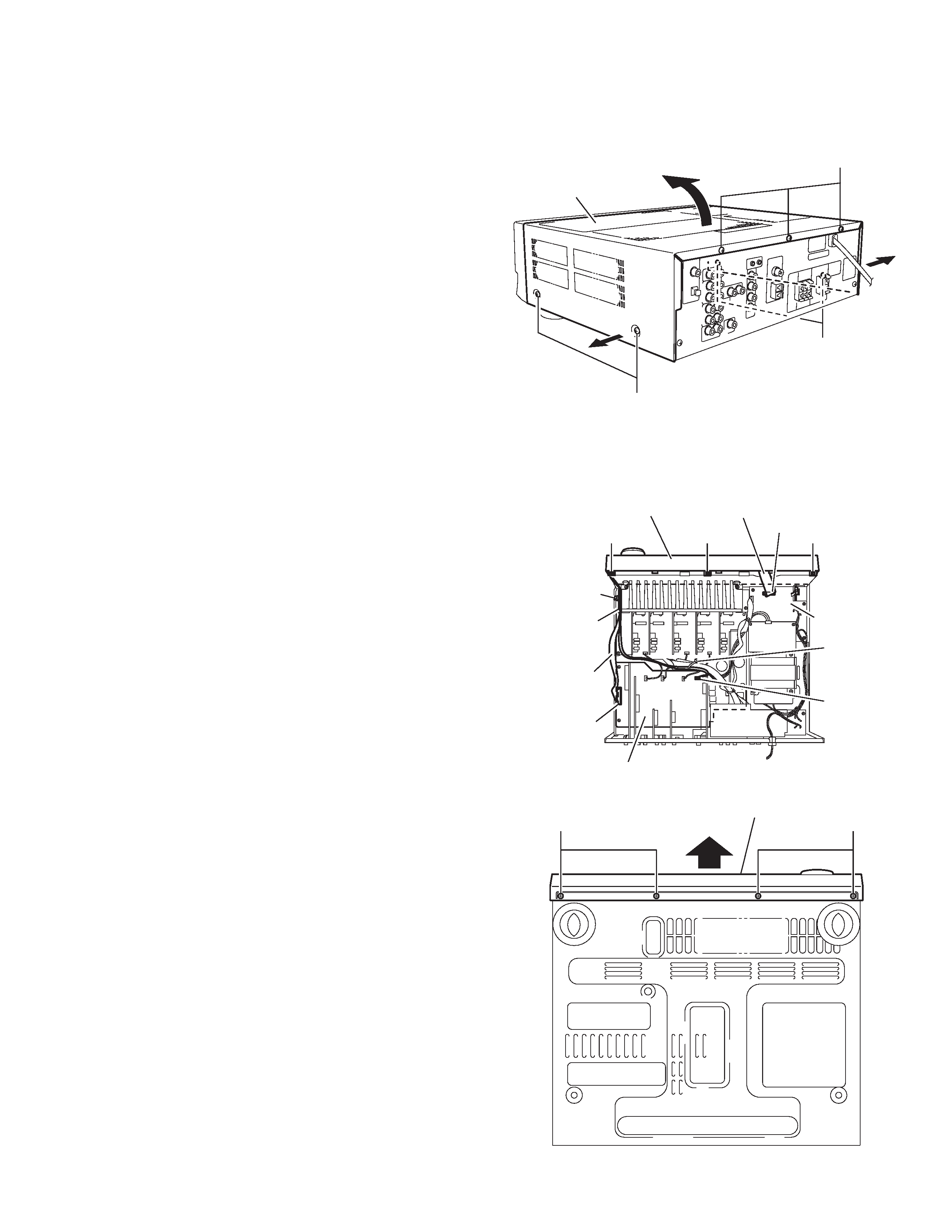
(No.22038)1-3
SECTION 2
Disassembly method
2.1 Removing the top cover
(See Fig.1)
(1) From the right and left sides of the main body, remove the
four screws A attaching the top cover.
(2) From the back side of the main body, remove the three
screws B attaching the top cover.
(3) Remove the top cover in the direction of the arrow 2 while
extending the lower sections of the top cover in the direc-
tion of the arrow 1.
Fig.1
2.2 Removing the front panel assembly
(See Figs.2 and 3)
· Prior to performing the following procedure, remove the top
cover.
(1) Disconnect the card wire from the connector CN402 on the
audio board. (See Fig.2)
(2) Disconnect the card wire from the connector CN201 on the
power supply board. (See Fig.2)
(3) Remove the tie band and wire protection board fixing the
card wire. (See Fig.2)
(4) Remove the tie band fixing the parallel wires, disconnect
the parallel wire from the connector CN403 on the audio
board. (See Fig.2)
(5) Remove the three screws C attaching the front panel as-
sembly. (See Fig.2)
(6) From the bottom side of the main body, remove the four
screws D attaching the front panel assembly. (See Fig.3)
(7) Remove the front panel assembly in the direction of the ar-
row. (See Fig.3)
Fig.2
Fig.3
B
A
A
2
1
1
Top cover
C
C
C
Front panel assembly Card wire
CN201
Power supply
board
Tie band
Wire protection
board
Card wire
CN402
Audio board
CN403
Tie band
DD
Front panel assembly
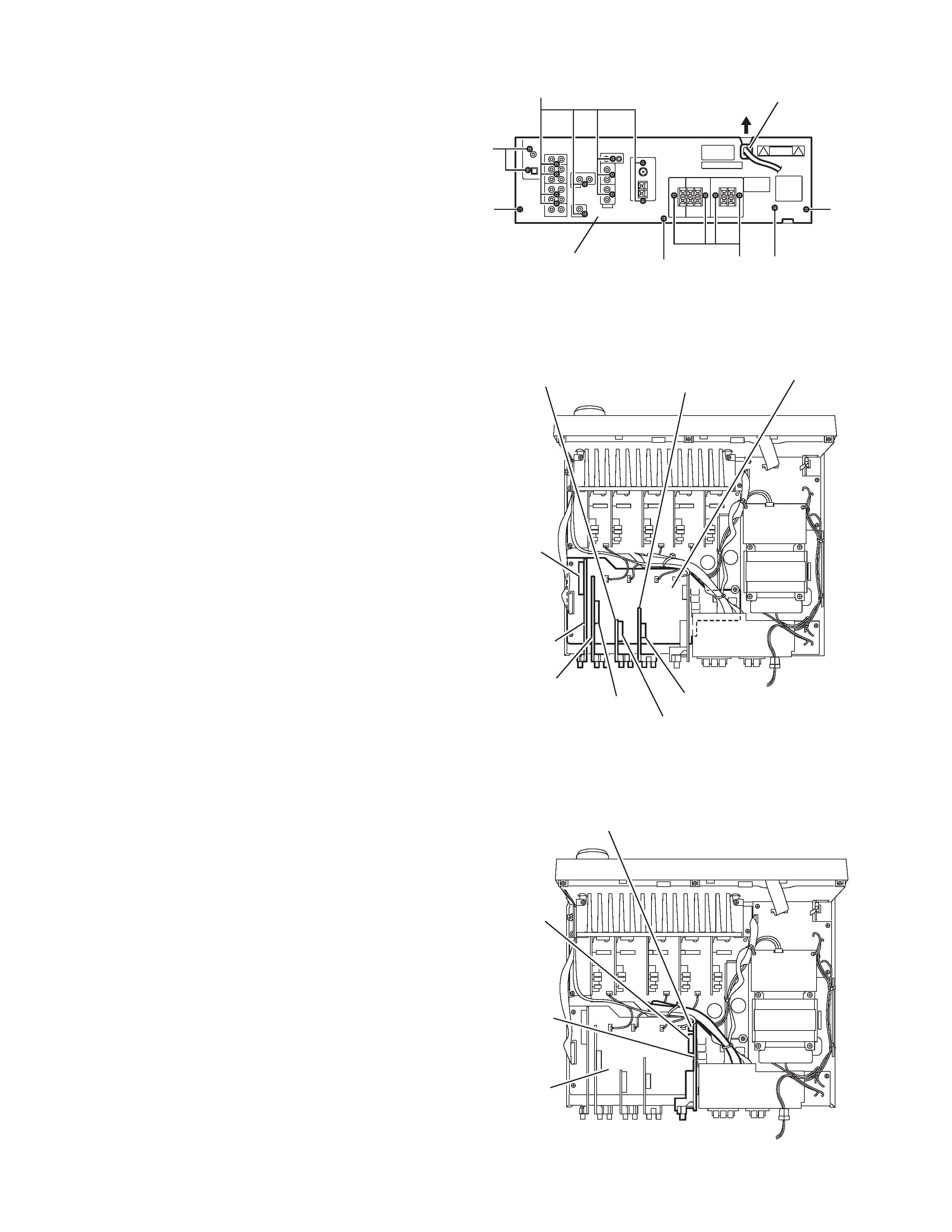
1-4 (No.22038)
2.3 Removing the rear panel
(See Fig.4)
· Prior to performing the following procedure, remove the top
cover.
(1) From the back side of the main body, remove the strain re-
lief from the rear panel in the direction of the arrow.
(2) Remove the seventeen screws E and four screws F attach-
ing the rear panel.
Fig.4
2.4 Removing the DSP board, audio input board, DVD board and video board
(See Fig.5)
· Prior to performing the following procedure, remove the top
cover and rear panel.
(1) From the top side of the main body, disconnect the DSP
board from the connector CN481 on the audio board.
(2) Disconnect the audio input board from the connector
CN421 on the audio board.
(3) Disconnect the DVD board from the connector CN431 on
the audio board.
(4) Disconnect the video board from the connector CN441 on
the audio board.
Fig.5
2.5 Removing the tuner board
(See Fig.6)
· Prior to performing the following procedure, remove the top
cover and rear panel.
(1) Disconnect the tuner board from the connectors CN411
and CN412 on the audio board.
Fig.6
E
E
F
EF
F
F
Strain relief
Rear panel
CN481
Audio board
DVD board
Video board
CN421
Audio input board
DSP board
CN431
CN441
Tuner board
CN411
CN412
Audio board
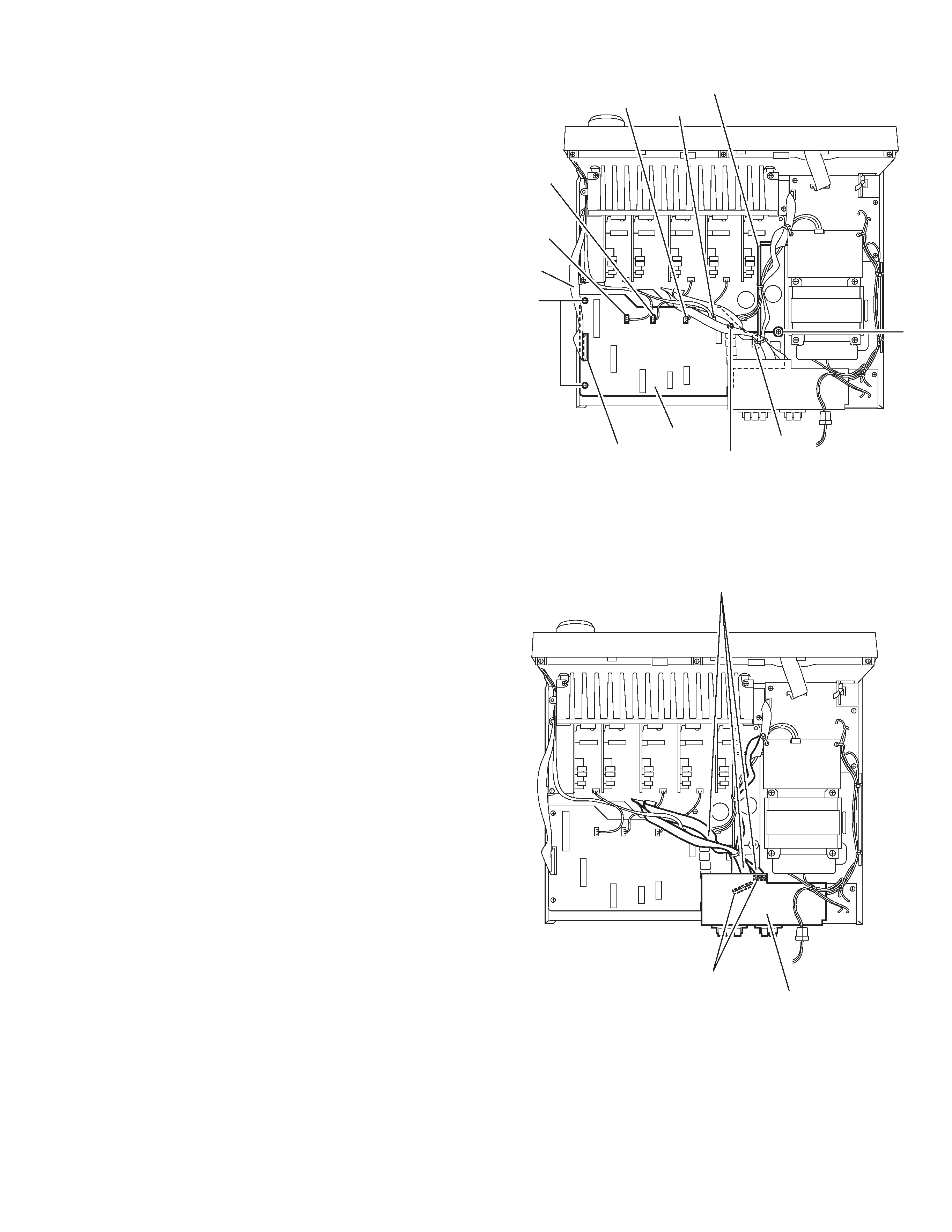
(No.22038)1-5
2.6 Removing the audio board
(See Fig.7)
· Prior to performing the following procedure, remove the top
cover, rear panel, DSP board, audio input board, DVD board,
video board and tuner board.
(1) From the top side of the main body, disconnect the card
wire from the connector CN402 on the audio board.
(2) Disconnect the parallel wire from the connector CN403.
(3) Disconnect the relay board from the connector CN491 on
the power supply board and audio board.
(4) Disconnect the wires from the connectors CN471, CN472
and CN473 on the audio board.
(5) Remove the three screws G attaching the audio board.
(6) Loosen the screw H attaching the audio board.
Fig.7
2.7 Removing the speaker terminal board
(See Fig.8)
· Prior to performing the following procedure, remove the top
cover and rear panel.
(1) From the top side of the main body, remove the solders
from the soldered sections a on the speaker terminal
board.
Fig.8
CN491
CN402
Audio board
Relay board
G
G
CN473
CN471
CN472
ard wire
CN403
Soldered sections a
Parallel wires
Speaker terminal board
